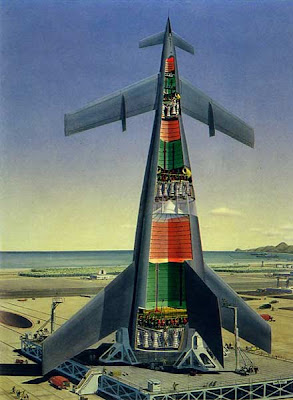- Joined
- Apr 13, 2011
- Messages
- 2,215
- Reaction score
- 0
- Points
- 36
- Location
- Los Angeles
- Website
- www.youtube.com
Yes, but that is the primary reason. Can you really think of anything more critical than not having your rocket exhaust pointed directly onto the end-dome of your external tank? :lol:
Also, what are these other reasons? I can think of some, but I really can't believe that this shockwave stuff is so universally limiting, just because some guy on the internet talked about it. I don't care who he is, or what his job is, or what degrees he completed, if he just said it, then it might as well just be apocryphal. Where is there any documentation that discusses this? Where is the documentation, that discusses flight loads on the shuttle stack as it was actually built? Where is the word, at least, of someone who actually worked on the STS program themself?
Well, the Shuttle really was always thought of being a side mount from the beginning in one form or another. The initial plane had it being flown to high altitude by another aircraft and then let go so it can boost itself into space.
Also the Shuttle was supposed to really be a space plane with a set of turbine engines for powered approach to the landing site.
But then someone at NASA noticed how the Air Force had already shown the vailidity of the un-powered approach utilizing the the steep slope to the TDZ compared to one that is normally utilized in powered approch, which is generally 3.0 degrees.
No turbines, less weight, so NASA went with that, but it was soon determined that a ship of this size with the giant delta wings and stabilizer was going to have to deal with pressure during ascent in a manner much different than with the capsules that came before. The shockwave and pressures but on the orbiter are a very serious thing, that is after all what destroyed the Challenger.
This pressure also required the SSMEs to be able to throttle.
Next would be the shear size of the stack. The Orbiter is the size of a DC-9, and having it sit on top of anything would be immensly unstable during the first parts of the flight, however brief.
Also the taller that stack the more pronounced the sandwhiching of the stack when the mains are fired. A real issue with the Saturn Vs, when the bottom of the stack and the F1s are fired, they want to fly through everything above them. Of course the stack was designed for this, and thus the whole rocket squished and then released that tension as things got underway, but with STS, the goal here was reusability, so that kind of action would certainly work against that.
One thing you metioned was how a side mounted orbiter causes the stack to pitch onto its backside. For the STS this is a plus. That tendency allows for greater course accuracy during ascent. Same as with the twang when the mains fire while the solids are still bolted to the pad.
By having the stack fall back, that eliminates a whole direction required for corrections. All the computers have to worry about is how slowly to let the pitch rise, slowly from zero to about 70 degrees over onto the back.
Now you are certainly right on safety. Orbiter ontop of the tank is many times safer. The biggest issues in STS safety was due to the side-mounted nature of the Orbiter, from the foam strikes and damage they did, the umbilical system to feed the fuel into the orbiters systems for the SSMEs was very problematic. Remember STS-133 being delayed time and again because it kept leaking. Thankfully it was noticed (not saying there was much of a chance it wasn't going to be, but hypothetically). And the ability for aboarts. The STS probably had some of the worst and craziest ideas for abort modes every concieved (aside from the ATO). Nothing could be done until the solids were burnt out, the mains had to still remain on during that time to keep the pressure normalized, then it was either pitch over on its side and burn the mains at 109 to kill velocity and establish a vector back to KSC, which is nuts, so nuts that when John Young heard that this was going to be the plan for STS-1, he said he would not do it.
With the top mount, more reasonable aborts could be managed, such as what has been demonstrated the Eridanus will simulate, with the rocket tower jet pulling the crew module away from the stack.









